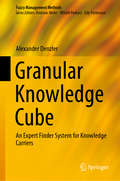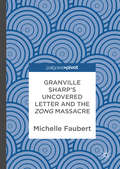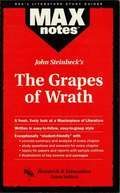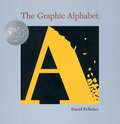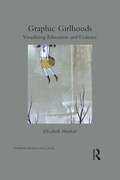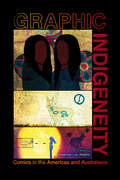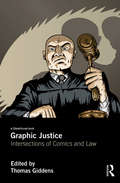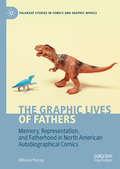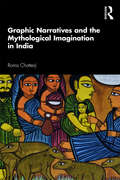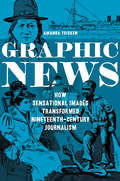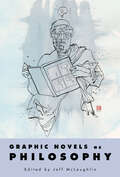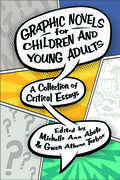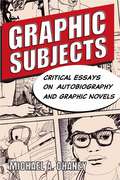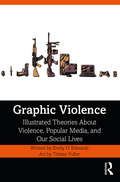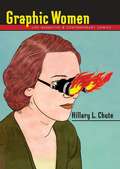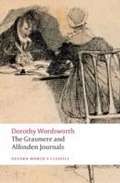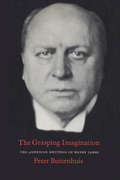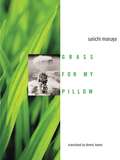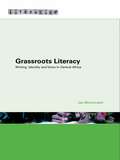- Table View
- List View
Granular Knowledge Cube: An Expert Finder System for Knowledge Carriers (Fuzzy Management Methods)
by Alexander DenzlerThis book introduces a novel type of expert finder system that can determine the knowledge that specific users within a community hold, using explicit and implicit data sources to do so. Further, it details how this is accomplished by combining granular computing, natural language processing and a set of metrics that it introduces to measure and compare candidates’ suitability. The book describes profiling techniques that can be used to assess knowledge requirements on the basis of a given problem statement or question, so as to ensure that only the most suitable candidates are recommended. The book brings together findings from natural language processing, artificial intelligence and big data, which it subsequently applies to the context of expert finder systems. Accordingly, it will appeal to researchers, developers and innovators alike.
Granville Sharp's Uncovered Letter and the Zong Massacre
by Michelle FaubertThis book delineates the discovery of a previously unknown manuscript of a letter from Granville Sharp, the first British abolitionist, to the “Lords Commissioners of the Admiralty.” In the letter, Sharp demands that the Admiralty bring murder charges against the crew of the Zong for forcing 132 enslaved Africans overboard to their deaths. Uncovered by Michelle Faubert at the British Library in 2015, the letter is reproduced here, accompanied by her examination of its provenance and significance for the history of slavery and abolition. As Faubert argues, the British Library manuscript is the only fair copy of Sharp’s letter, and extraordinary evidence of Sharp’s role in the abolition of slavery.
The Grapes of Wrath (MAXNotes Literature Guides)
by Lee CusickREA's MAXnotes for John Steinbeck's The Grapes of Wrath MAXnotes offer a fresh look at masterpieces of literature, presented in a lively and interesting fashion. Written by literary experts who currently teach the subject, MAXnotes will enhance your understanding and enjoyment of the work. MAXnotes are designed to stimulate independent thought about the literary work by raising various issues and thought-provoking ideas and questions. MAXnotes cover the essentials of what one should know about each work, including an overall summary, character lists, an explanation and discussion of the plot, the work's historical context, illustrations to convey the mood of the work, and a biography of the author. Each chapter is individually summarized and analyzed, and has study questions and answers.
The Grapes of Wrath SparkNotes Literature Guide (SparkNotes Literature Guide Series #28)
by SparkNotesThe Grapes of Wrath SparkNotes Literature Guide by John Steinbeck Making the reading experience fun! When a paper is due, and dreaded exams loom, here's the lit-crit help students need to succeed! SparkNotes Literature Guides make studying smarter, better, and faster. They provide chapter-by-chapter analysis; explanations of key themes, motifs, and symbols; a review quiz; and essay topics. Lively and accessible, SparkNotes is perfect for late-night studying and paper writing. Includes:An A+ Essay—an actual literary essay written about the Spark-ed book—to show students how a paper should be written.16 pages devoted to writing a literary essay including: a glossary of literary termsStep-by-step tutoring on how to write a literary essayA feature on how not to plagiarize
The Graphic Alphabet
by David PelletierMost alphabet books for pre-readers and early readers set out to make the somewhat abstract idea of letters as clear and as clearly linked to words as possible. In The Graphic Alphabet, graphic designer David Pelletier has created an alphabet book that aims to explore letters for their beauty and complexity as design elements as well as help teach kids how to read. His "A," for example, stands for "avalanche," and with its normally pointed top tumbling down the right diagonal, the letter doesn't just stand for the avalanche, it becomes the word. Pelletier is equally ingenious throughout. And while this might not be the best book to make the concept of letters concrete for youngsters, it will certainly help instill in them a sense of wonder about letters and words. <P><P> Winner of the Caldecott Honor
Graphic Girlhoods: Visualizing Education and Violence (Children's Literature And Culture Ser.)
by Elizabeth MarshallDrawing on a dynamic set of "graphic texts of girlhood," Elizabeth Marshall identifies the locations, cultural practices, and representational strategies through which schoolgirls experience real and metaphorical violence. How is the schoolgirl made legible through violence in graphic texts of girlhood? What knowledge about girlhood and violence are under erasure within mainstream images and scripts about the schoolgirl? In what ways has the schoolgirl been pictured in graphic narratives to communicate feminist knowledge, represent trauma, and/or testify about social violence? Graphic Girlhoods focuses on these questions to make visible and ultimately question how sexism, racism and other forms of structural violence inform education and girlhood. From picture books about mean girls The Recess Queen or graphic novels like Jane, The Fox and Me to Ronald Searle's ghastly pupils in the St. Trinian's cartoons to graphic memoirs about schooling by adult women, such as Ruby Bridges's Through My Eyes and Lynda Barry's One Hundred Demons texts for and about the schoolgirl stake a claim in ongoing debates about gender and education.
Graphic Indigeneity: Comics in the Americas and Australasia
by Frederick Luis AldamaHonorable Mention Recipient for the Comics Studies Society Prize for Edited Book CollectionContributions by Joshua T. Anderson, Chad A. Barbour, Susan Bernardin, Mike Borkent, Jeremy M. Carnes, Philip Cass, Jordan Clapper, James J. Donahue, Dennin Ellis, Jessica Fontaine, Jonathan Ford, Lee Francis IV, Enrique García, Javier García Liendo, Brenna Clarke Gray, Brian Montes, Arij Ouweneel, Kevin Patrick, Candida Rifkind, Jessica Rutherford, and Jorge Santos Cultural works by and about Indigenous identities, histories, and experiences circulate far and wide. However, not all films, animation, television shows, and comic books lead to a nuanced understanding of Indigenous realities. Acclaimed comics scholar Frederick Luis Aldama shines light on how mainstream comics have clumsily distilled and reconstructed Indigenous identities and experiences. He and contributors emphasize how Indigenous comic artists are themselves clearing new visual-verbal narrative spaces for articulating more complex histories, cultures, experiences, and narratives of self. To that end, Aldama brings together scholarship that explores both the representation and misrepresentation of Indigenous subjects and experiences as well as research that analyzes and highlights the extraordinary work of Indigenous comic artists. Among others, the book examines Daniel Parada’s Zotz, Puerto Rican comics Turey el Taíno and La Borinqueña, and Moonshot: The Indigenous Comics Collection. This volume’s wide-armed embrace of comics by and about Indigenous peoples of the Americas and Australasia is a first step to understanding how the histories of colonial and imperial domination connect the violent wounds that still haunt across continents. Aldama and contributors resound this message: Indigeneity in comics is an important, powerful force within our visual-verbal narrative arts writ large.
Graphic Justice: Intersections of Comics and Law
by Thomas GiddensThe intersections of law and contemporary culture are vital for comprehending the meaning and significance of law in today’s world. Far from being unsophisticated mass entertainment, comics and graphic fiction both imbue our contemporary culture, and are themselves imbued, with the concerns of law and justice. Accordingly, and spanning a wide variety of approaches and topics from an international array of contributors, Graphic Justice draws comics and graphic fiction into the range of critical resources available to the academic study of law. The first book to do this, Graphic Justice broadens our understanding of law and justice as part of our human world—a world that is inhabited not simply by legal concepts and institutions alone, but also by narratives, stories, fantasies, images, and other cultural articulations of human meaning. Engaging with key legal issues (including copyright, education, legal ethics, biomedical regulation, and legal personhood) and exploring critical issues in criminal justice and perspectives on international rights, law and justice—all through engagement with comics and graphic fiction—the collection showcases the vast breadth of potential that the medium holds. Graphic Justice will be of interest to academics and postgraduate students in: cultural legal studies; law and the image; law, narrative and literature; law and popular culture; cultural criminology; as well as cultural and comics studies more generally.
The Graphic Lives of Fathers: Memory, Representation, and Fatherhood in North American Autobiographical Comics (Palgrave Studies in Comics and Graphic Novels)
by Mihaela PrecupThis book explores the representation of fatherhood in contemporary North American autobiographical comics that depict paternal conduct from the post-war period up to the present. It offers equal space to autobiographical comics penned by daughters who represent their fathers’ complicated and often disappointing behavior, and to works by male cartoonists who depict and usually celebrate their own experiences as fathers. This book asks questions about how the desire to forgive or be forgiven can compromise the authors’ ethics or dictate style, considers the ownership of life stories whose subjects cannot or do not agree to be represented, and investigates the pervasive and complicated effects of dominant masculinities. By close reading these cartoonists’ complex strategies of (self-)representation, this volume also places photography and archival work alongside the problematic legacy of self-deprecation carried on from underground comics, and shows how the vocabulary of graphic narration can work with other media and at the intersection of various genres and modes to produce a valuable scrutiny of contemporary norms of fatherhood.
Graphic Migrations: Precarity and Gender in India and the Diaspora (Asian American History & Cultu #222)
by Kavita DaiyaIn Graphic Migrations, Kavita Daiya provides a literary and cultural archive of refugee stories and experiences to respond to the question “What is created?” after decolonization and the 1947 Partition of India. She explores how stories of Partition migrations shape and influence the political and cultural imagination of secularism and contribute to gendered citizenship for South Asians in India and its diasporas. Daiya analyzes modern literature, Bollywood films, Margaret Bourke-White’s photography, advertising, and print culture to show how they memorialize or erase refugee experiences. She also uses oral testimonies of Partition refugees from Hong Kong, South Asia, and North America to draw out the tensions of the nation-state, ethnic discrimination, and religious difference. Employing both Critical Refugee Studies and Feminist Postcolonial Studies frameworks, Daiya traces the cultural, affective, and political legacies of Partition migrations. The precarity generated by modern migration and expressed through public culture prompts a rethinking of how dominant media represents gendered migrants and refugees. Graphic Migrations demands that we redraw the boundaries of how we tell the story of modern world history and the intricately interwoven, intimate production of statelessness and citizenship across the world’s communities.
Graphic Narratives and the Mythological Imagination in India
by Roma ChatterjiThis book explores graphic narratives and comics in India and demonstrates how these forms serve as sites on which myths are enacted and recast. It uses the case studies of a comics version of the Mahabharata War, a folk artist’s rendition of a comic book story, and a commercial project to re-imagine two of India’s most famous epics – the Ramayana and the Mahabharata – as science fiction and superhero tales. It discusses comic books and self-published graphic novels; bardic performance aided with painted scrolls and commercial superhero comics; myths, folklore, and science fiction; and different pictorial styles and genres of graphic narration and storytelling. It also examines the actual process of the creation of comics besides discussions with artists on the tools and location of the comics medium as well as the method and impact of translation and crossover genres in such narratives. With its clear, lucid style and rich illustrations, the book will be useful to scholars and researchers of sociology, anthropology, visual culture and media, and South Asian studies, as well as those working on art history, religion, popular culture, graphic novels, art and design, folk culture, literature, and performing arts.
Graphic News: How Sensational Images Transformed Nineteenth-Century Journalism (History of Communication #148)
by Amanda Frisken”You furnish the pictures and I’ll furnish the war.” This famous but apocryphal quote, long attributed to newspaper magnate William Randolph Hearst, encapsulates fears of the lengths to which news companies would go to exploit visual journalism in the late nineteenth century. From 1870 to 1900, newspapers disrupted conventional reporting methods with sensationalized line drawings. A fierce hunger for profits motivated the shift to emotion-driven, visual content. But the new approach, while popular, often targeted, and further marginalized, vulnerable groups. Amanda Frisken examines the ways sensational images of pivotal cultural events—obscenity litigation, anti-Chinese bloodshed, the Ghost Dance, lynching, and domestic violence—changed the public's consumption of the news. Using intersectional analysis, Frisken explores how these newfound visualizations of events during episodes of social and political controversy enabled newspapers and social activists alike to communicate—or challenge—prevailing understandings of racial, class, and gender identities and cultural power.
The Graphic Novel
by Jan Baetens Hugo FreyThe essays collected in this volume were first presented at the international and interdisciplinary conference on the Graphic Novel hosted by the Institute for Cultural Studies (University of Leuven) in 2000. The issues discusses by the conference are twofold. Firstly, that of trauma representation, an issue escaping by definition from any imaginable specific field. Secondly, that of a wide range of topics concerning the concept of "visual narrative," an issue which can only be studied by comparing as many media and practices as possible. The essays of this volume are grouped here in two major parts, their focus depending on either a more general topic or on a very specific graphic author. The first part of the book, "Violence and trauma in the Graphic Novel", opens with a certain number of reflections on the representation of violence in literary and visual graphic novels, and continues with a whole set of close readings of graphic novels by Art Spiegelman (Maus I and II) and Jacques Tardi (whose masterwork "C'?tait la guerre des tranch'es" is still waiting for its complete English translation). The second part of the book presents in the first place a survey of the current graphic novel production, and insists sharply on the great diversity of the range in the various 'continental' traditions (for instance underground 'comix', and feminist comics, high-art graphic novels, critical superheroes-fiction) whose separation is nowadays increasingly difficult to maintain. It continues and ends with a set of theoretical interventions where not only the reciprocal influences of national and international traditions, but also those between genres and media are strongly forwarded, the emphasis being here mainly on problems concerning ways of looking and positions of spectatorship.
Graphic Novels as Philosophy
by Jeff McLaughlinContributions by Eric Bain-Selbo, Jeremy Barris, Maria Botero, Manuel “Mandel” Cabrera Jr., David J. Leichter, Ian MacRae, Jeff McLaughlin, Alfonso Muñoz-Corcuera, Corry Shores, and Jarkko TuusvuoriIn a follow-up to Comics as Philosophy, international contributors address two questions: Which philosophical insights, concepts, and tools can shed light on the graphic novel? And how can the graphic novel cast light on the concerns of philosophy? Each contributor ponders a well-known graphic novel to illuminate ways in which philosophy can untangle particular combinations of image and written word for deeper understanding.Jeff McLaughlin collects a range of essays to examine notable graphic novels within the framework posited by these two questions. One essay discusses how a philosopher discovered that the panels in Jeff Lemire’s Essex County do not just replicate a philosophical argument, but they actually give evidence to an argument that could not have existed otherwise. Another essay reveals how Chris Ware’s manipulation of the medium demonstrates an important sense of time and experience. Still another describes why Maus tends to be more profound than later works that address the Holocaust because of, not in spite of, the fact that the characters are cartoon animals rather than human.Other works contemplated include Will Eisner’s A Contract with God, Alan Moore and David Lloyd’s V for Vendetta, Alison Bechdel’s Fun Home, and Joe Sacco’s Footnotes in Gaza. Mainly, each essay, contributor, graphic novelist, and artist is doing the same thing: trying to tell us how the world is—at least from their point of view.
Graphic Novels for Children and Young Adults: A Collection of Critical Essays (Children's Literature Association Series)
by Michelle Ann Abate & Gwen Athene TarboxWith contributions by Eti Berland, Rebecca A. Brown, Christiane Buuck, Joanna C. Davis-McElligatt, Rachel Dean-Ruzicka, Karly Marie Grice, Mary Beth Hines, Krystal Howard, Aaron Kashtan, Michael L. Kersulov, Catherine Kyle, David E. Low, Anuja Madan, Meghann Meeusen, Rachel L. Rickard Rebellino, Rebecca Rupert, Cathy Ryan, Joe Sutliff Sanders, Joseph Michael Sommers, Marni Stanley, Gwen Athene Tarbox, Sarah Thaller, Annette Wannamaker, and Lance WeldyOne of the most significant transformations in literature for children and young adults during the last twenty years has been the resurgence of comics. Educators and librarians extol the benefits of comics reading, and increasingly, children's and YA comics and comics hybrids have won major prizes, including the Printz Award and the National Book Award. Despite the popularity and influence of children's and YA graphic novels, the genre has not received adequate scholarly attention.Graphic Novels for Children and Young Adults is the first book to offer a critical examination of children's and YA comics. The anthology is divided into five sections, structure and narration; transmedia; pedagogy; gender and sexuality; and identity, that reflect crucial issues and recurring topics in comics scholarship during the twenty-first century. The contributors are likewise drawn from a diverse array of disciplines--English, education, library science, and fine arts. Collectively, they analyze a variety of contemporary comics, including such highly popular series as Diary of a Wimpy Kid and Lumberjanes; Eisner award-winning graphic novels by Gene Luen Yang, Nate Powell, Mariko Tamaki, and Jillian Tamaki; as well as volumes frequently challenged for use in secondary classrooms, such as Raina Telgemeier's Drama and Sherman Alexie's The Absolutely True Diary of a Part-Time Indian.
Graphic Subjects
by Michael A. ChaneySome of the most noteworthy graphic novels and comic books of recent years have been entirely autobiographical. InGraphic Subjects, Michael A. Chaney brings together a lively mix of scholars to examine the use of autobiography within graphic novels, including such critically acclaimed examples as Art Spiegelman'sMaus, David Beauchard'sEpileptic, Marjane Satrapi'sPersepolis, Alan Moore'sWatchmen, and Gene Yang'sAmerican Born Chinese. These essays, accompanied by visual examples, illuminate the new horizons that illustrated autobiographical narrative creates. The volume insightfully highlights the ways that graphic novelists and literary cartoonists have incorporated history, experience, and life stories into their work. The result is a challenging and innovative collection that reveals the combined power of autobiography and the graphic novel.
Graphic Violence: Illustrated Theories about Violence, Popular Media, and Our Social Lives
by Emily EdwardsGraphic Violence provides an innovative introduction to the relationship between violence and visual media, discussing how media consumers and producers can think critically about and interact with violent visual content. It comprehensively surveys predominant theories of media violence and the research supporting and challenging them, addressing issues ranging from social learning, to representations of war and terrorism, to gender and hyper-masculinity. Each chapter features original artwork presenting a story in the style of a graphic novel to demonstrate the concepts at hand. Truly unique in its approach to the subject and medium, this volume is an excellent resource for undergraduate students of communication and media theory as well as anyone interested in understanding the causes and effects of violence in media.
Graphic Women: Life Narrative and Contemporary Comics (Gender and Culture Series)
by Hillary ChuteSome of the most acclaimed books of the twenty-first century are autobiographical comics by women. Aline Kominsky-Crumb is a pioneer of the autobiographical form, showing women's everyday lives, especially through the lens of the body. Phoebe Gloeckner places teenage sexuality at the center of her work, while Lynda Barry uses collage and the empty spaces between frames to capture the process of memory. Marjane Satrapi's Persepolis experiments with visual witness to frame her personal and historical narrative, and Alison Bechdel's Fun Home meticulously incorporates family documents by hand to re-present the author's past.These five cartoonists move the art of autobiography and graphic storytelling in new directions, particularly through the depiction of sex, gender, and lived experience. Hillary L. Chute explores their verbal and visual techniques, which have transformed autobiographical narrative and contemporary comics. Through the interplay of words and images, and the counterpoint of presence and absence, they express difficult, even traumatic stories while engaging with the workings of memory. Intertwining aesthetics and politics, these women both rewrite and redesign the parameters of acceptable discourse.
Graphic Women: Life Narrative and Contemporary Comics
by Hillary L. ChuteFemale cartoonists are playing a central role in the evolution of "graphic novels." Some of the most acclaimed books of the twenty-first century, such as Marjane Satrapi's Persepolis and Alison Bechdel's Fun Home, are autobiographical comics by women. Aline Kominsky-Crumb pioneered the autobiographical form, showing women's everyday lives, especially through the lens of the body. Phoebe Gloeckner places teenage sexuality at the center of her work, while Lynda Barry uses collage and the empty spaces between frames to capture the process of memory. Satrapi experiments with visual witness to frame her personal and historical narrative, and Bechdel meticulously incorporates family documents by hand to re-present her past. These five cartoonists move the art of autobiography and graphic storytelling in new directions, particularly through the depiction of sex, gender, and lived experience. Hillary L. Chute explores their verbal and visual techniques, which have transformed autobiographical narrative and contemporary comics. Through the interplay of words and images and the counterpoint of presence and absence, they express difficult, even traumatic stories while engaging with the workings of memory. Intertwining aesthetics and politics, these women both rewrite and redesign the parameters of acceptable discourse.
Graphing Jane Austen
by Joseph Carroll Jonathan Gottschall John A. Johnson Daniel J. KrugerThis book helps to bridge the gap between science and literary scholarship. Building on findings in the evolutionary human sciences, the authors construct a model of human nature in order to illuminate the evolved psychology that shapes the organization of characters in nineteenth-century British novels, from Jane Austen to E. M. Forster.
The Grasmere and Alfoxden Journals
by Dorothy Wordsworth Pamela WoofDorothy Wordsworth's journals are a unique record of her life with her brother William, at the time when he was at the height of his poetic powers. Invaluable for the insight they give into the daily life of the poet and his friendship with Coleridge, they are also remarkable for their spontaneity and immediacy, and for the vivid descriptions of people, places, and incidents that inspired some of Wordsworth's best-loved poems. The Grasmere Journal was begun at Dove Cottage in May 1800 and kept for three years. Dorothy notes the walks and the weather, the friends, country neighbors and beggars on the roads; she sets down accounts of the garden, of Wordsworth's marriage, their concern for Coleridge, the composition of poetry. The earlier Alfoxden Journal was written during 1797-8, when the Wordsworths lived near Coleridge in Somerset. Not intended for publication, but to "give Wm Pleasure by it," both journals have a quality recognized by Wordsworth when he wrote of Dorothy that "she gave me eyes, she gave me ears."
The Grasping Imagination: The American Writings of Henry James
by Peter Martinus BuitenhuisThere has been almost no study of the American writings of Henry James, that is, the fiction, essays, and travel literature with an American setting. The great bulk of Jamesian criticism deals with the international novels, particularly his late works.This study places James's career in a new perspective by discussing its American aspect. It gives the critic an opportunity to come to grips with the evolution of James's technique from his second short story to his penultimate, unfinished novel, The Ivory Tower.
Grass for My Pillow
by Dennis Keene Saiichi MaruyaFirst published in Japanese in 1966, the debut novel of the critically acclaimed author of Singular Rebellion is an unusual portrait of a deeply taboo subject in twentieth-century Japanese society: resistance to the draft in World War II. In 1940 Shokichi Hamada is a conscientious objector who dodges military service by simply disappearing from society, taking to the country as an itinerant peddler by the name of Sugiura until the end of the war in 1945. In 1965, Hamada works as a clerk at a conservative university, his war resistance a dark secret of the past that present-day events force into the light, confronting him with unexpected consequences of his refusal to conform twenty years earlier.
Grass For My Pillow (Modern Asian Literature Ser.)
by Saiichi MaruyaFirst published in Japanese in 1966, the debut novel of the critically acclaimed author of Singular Rebellion is an unusual portrait of a deeply taboo subject in twentieth-century Japanese society: resistance to the draft in World War II. In 1940 Shokichi Hamada is a conscientious objector who dodges military service by simply disappearing from society, taking to the country as an itinerant peddler by the name of Sugiura until the end of the war in 1945. In 1965, Hamada works as a clerk at a conservative university, his war resistance a dark secret of the past that present-day events force into the light, confronting him with unexpected consequences of his refusal to conform twenty years earlier.
Grassroots Literacy: Writing, Identity and Voice in Central Africa (Literacies)
by Jan BlommaertWhat effect has globalization had on our understanding of literacy? Grassroots Literacy seeks to address the relationship between globalization and the widening gap between ‘grassroots’ literacies, or writings from ordinary people and local communities, and ‘elite’ literacies. Displaced from their original context to elite literacy environments in the form of letters, police declarations and pieces of creative writing, ‘grassroots’ literacies are unsurprisingly easily disqualified, either as ‘bad’ forms of literacy, or as messages that fail to be understood. Through close analysis of two unique, handwritten documents from the Democratic Republic of the Congo, Jan Blommaert considers how ‘grassroots’ literacy in the Third World develops outside the literacy-saturated environments of the developed world. In examining these documents produced by socially and economically marginalized writers Blommaert demonstrates how literacy environments should be understood as relatively autonomous systems. Grassroots Literacy will be key reading for students of language and literacy studies as well as an invaluable resource for anyone with an interest in understanding the implications of globalization on local literacy practices.
